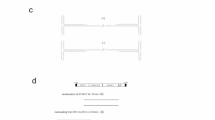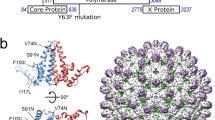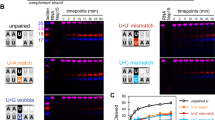Abstract
HEPATITIS delta virus genomic and antigenomic RNAs contain a self-cleavage site hypothesized to function in processing the viral RNA during replication1–3. Self-cleavage requires only a divalent cation1–3 and is mediated at the genomic site by a sequence of less than 85 nucleotides4. We propose that the genomic self-cleaving sequence element4 and a corresponding sequence from the anti-genomic RNA could generate related secondary structures. The region of the antigenomic sequence, predicted from the proposed structure, was synthesized and shown to be sufficient for self-cleavage. Evidence for two stems which form a tertiary interaction was obtained by site-specific mutagenesis of the antigenomic sequence. Efficient self-cleavage in 10 M formamide or 5 M urea, also a property of the genomic sequence5, was dependent on base-pairing in both stems. But in the absence of denaturants, the stem distal to the site of cleavage was not required, suggesting that the tertiary interaction stabilizes the structure required for self-cleavage.
This is a preview of subscription content, access via your institution
Access options
Subscribe to this journal
Receive 51 print issues and online access
$199.00 per year
only $3.90 per issue
Buy this article
- Purchase on SpringerLink
- Instant access to full article PDF
Prices may be subject to local taxes which are calculated during checkout
Similar content being viewed by others
References
Kuo, M. Y.-P., Sharmeen, L., Dinter-Gottlieb, G. & Taylor, J. J. Virol. 62, 4439–4444 (1988).
Sharmeen, L., Kuo, M. Y.-P., Dinter-Gottlieb, G. & Taylor, J. J. Virol 62, 2674–2679 (1988).
Wu, H.-N. et al. Proc. natn. Acad. Sci. U.S.A. 86, 1831–1835 (1989).
Perrotta, A. T. & Been, M. D. Nucleic Acids Res. 18, 6821–6827 (1990).
Rosenstein, S. P. & Been, M. D. Biochemistry 29, 8011–8016 (1990).
Forster, A. C. & Symons, R. H. Cell 49, 211–220 (1987).
Forster, A. C. & Symons, R. H. Cell 50, 9–16 (1987).
Hampel, A., Tritz, R., Hicks, M. & Cruz, P. Nucleic Acids Res. 18, 299–304 (1990).
Pleij, C. W. A. Trends biochem. Sci. 15, 143–147 (1990).
Wang, K.-S. et al. Nature 323, 508–514 (1986).
Kuo, M. Y.-P. et al. J. Virol. 62, 1855–1861 (1988).
Makino, S. et al. Nature 329, 343–346 (1987).
Kunkel, T., Roberts, J. D. & Zakour, R. A. Meth. Enzym. 154, 367–382 (1987).
Vieira, J. & Messing, J. Meth. Enzym. 154, 3–11 (1987).
Author information
Authors and Affiliations
Rights and permissions
About this article
Cite this article
Perrotta, A., Been, M. A pseudoknot-like structure required for efficient self-cleavage of hepatitis delta virus RNA. Nature 350, 434–436 (1991). https://doi.org/10.1038/350434a0
Received:
Accepted:
Issue Date:
DOI: https://doi.org/10.1038/350434a0



